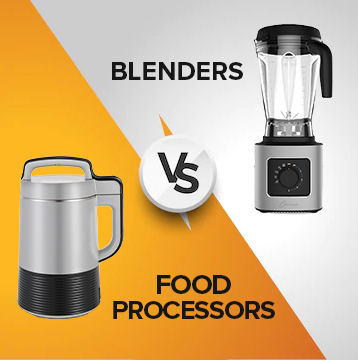Blenders vs. Food Processors: All important differences
Ever found yourself staring in the kitchen wondering whether you need a blender or food processor? You’re not alone! The question of food processors vs blenders can get a little murky, especially when both machines seem to do it all. So let’s break it down and help you decide which one fits best.
Blenders: Your smoothie and soup bestie
Blenders are the champs of anything liquidy or silky smooth. Think smoothies, soups, sauces, nut milks, nut butters and even crushing ice for all those nutritious drinks. They’re all about taking ingredients and turning them into a creamy masterpiece.
Take the Optimum 9200A 2nd Generation, for example. It’s a powerhouse for those green smoothies packed with fruits and veggies. If you’re after something sleeker but mighty, the Optimum G2.6 Slim Platinum Series delivers high performance in a compact package with a variable speed dial. For everyday blending, the Optimum 9400 Essential keeps things reliable with its glass jug, while the Optimum 9400X ups the ante with more power and longer blades for better blends. You can even get it with a sound cover for quiet blending. When it comes to the food processors vs blenders showdown, blenders are all about that silky texture.

View this post on Instagram
Food Processors: The precision pros
Food processors, on the other hand, are the ultimate prep machine. From slicing and dicing to shredding and mixing, they handle the nitty gritty tasks that can be time-consuming. Whether it’s grating cheese, making dough, or chopping veggies, a food processor has got your back.
The Optimum Thermocook Pro M 3.0 is a multitasking beast, it chops, slices and cooks. It comes with food processing attachments, making it even more versatile. Want a classic food processor? The Optimum 8 Cup Food Processor is compact yet powerful, that can tackle everyday prep like a pro. It’s clear that in the food processors vs blenders debate, food processors win at the food prep precision.

Food Processors Vs Blenders: What’s the difference?
Let’s talk about design and purpose. Blenders usually come with tall jugs and multiple blades that create a vortex, pulling both wet and dry ingredients towards the middle for that smooth and consistent blend. This makes them awesome for liquids and creamy textures. Meanwhile, food processors have wide bowls and interchangeable S blades and discs, perfect for chopping, slicing and grating. If you’re working with solid or semi-solid foods, a food processor will be your go-to.

Power play: How they differ
The motors and blades in these machines also serve different purposes. Blenders, like the Optimum 9400X commercial blender pack serious power, boasting 2611 watts, allowing them to crush ice and blend the toughest ingredients like ice, nuts, grains and frozen fruits. On the other hand, food processors typically feature motors with less than 1000 watts, focusing more on torque to deliver precise cutting, shredding and kneading dough. It’s these differences that define the food processors vs blenders debate.
What’s your kitchen style?
Are you a smoothie enthusiast? Then go for a blender like the Optimum G2.6 Slim Platinum Series or Optimum 9200A 2nd Generation. Love soups and sauces? Blenders are your jam. But if you’re whipping up pizza dough, shredding carrots for a salad, or slicing potatoes for a gratin, a food processor like the Optimum 8 Cup Food Processor will be your best friend. Choosing between food processors vs blenders really boils down to how you love to cook.
Why not both?
Can’t choose? You don’t have to! The Optimum Thermocook Pro M 3.0 is a genius hybrid that blends, chops, cooks and more.
Packed with 2400 watts of power and over 20 functions, it comes with a large 3-litre stainless steel bowl with food processing attachments for all your recipes. With a choice of a 7" or 10" LCD touchscreen display, you can easily navigate the automatic and manual cooking functions. The built-in scales make precise measurements a breeze, while the WIFI connectivity and dedicated app open up access to over 1000 delicious recipes. It’s like having the best of both worlds in one shiny machine.
If the food processors vs blenders debate feels too limiting, hybrids like this let you have your cake and eat it too, or at least mix the batter and whip up a smoothie while you’re at it.
Wrapping it up: Food Processors vs Blenders
At the end of the day, the choice between food processors vs blenders comes down to your needs. Both machines are kitchen game-changers in their own way. Whether you’re into silky smoothies or need a helping hand with food prep, there’s a perfect match out there. So, which team are you on? Smooth and creamy, or precise and chopped? Either way, you’ll be winning in the kitchen. Check out the full range of Optimum blenders and multi-cooker companions here.




